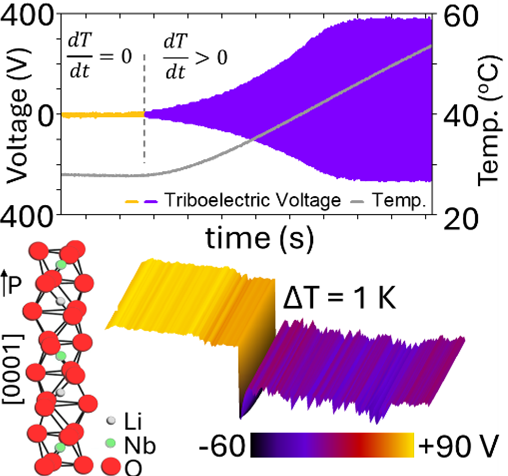Why not inorganic ferroelectrics for triboelectric nanogenerators?

A CQMT based QUB team working in an international collaboration with Australian and Chinese research teams has demonstrated exceptional coupling of pyro-triboelectric effect in inorganic ferroelectrics for developing Pyroelectric LiNbO3 Triboelectric Nanogenerators (PL-TENGs), significantly outperforming the conventional triboelectric nanogenerators.
Remember the last time you made your hair stand by bringing an inflated balloon rubbed against a piece of cloth or wool! What you are exploiting is the triboelectric effect which occurs when two dielectric materials are rubbed against each other resulting in charged surfaces upon separation. The effect has a host of applications in practical settings and triboelectric nanogenerators which convert mechanical energy to electrical energy have emerged as viable energy conversion devices. The efficiency and voltage output of such triboelectric nanogenerator devices has become topic of hot interest among researchers and efforts are on to enhance the output of such devices. A key strategy to achieve this is to choose materials which can provide dramatically enhanced charge densities and hence voltage outputs.
Multifunctional, ferroelectric fluoropolymers are regarded as the de facto materials for triboelectric nanogenerators. However, their comparatively low polarisation, dielectric constants, and pyroelectric coefficients result in sub-optimal pyroelectric-triboelectric coupling. While flexible ferroelectric polymers dominate the field, their temperature gradient conversion capabilities are far outperformed by oxides, which remain severely underutilized despite their potential. Inorganic oxides such as PZT exhibit pyroelectric coefficients significantly higher than PVDF. Other oxides, such as LiNbO₃, can convert temperature fluctuations efficiently into large surface charges. For instance, a 10 mm thick z-cut (0001) LiNbO₃ crystal, can achieve surface potentials up to ~3 kV and an ideal surface charge density of 0.7 C.m-2 with just a 1 K temperature change, far outperforming the charge density limitations of flexible polymers or the need to maintaining the extremely high-temperature differences between friction layers or complicated device architecture indeed.
Dr. Niyorjyoti Sharma, one of the co-authors based in QUB commented ‘In this work, we have demonstrated the potential of LiNbO3 crystals in coupled Pyroelectric-LiNbO3 Triboelectric Nanogenerators (PL-TENGs) for harvesting waste, low-grade heat and temperature monitoring. We employed novel high voltage Kelvin probe force microscopy technique (developed recently at QUB) to reveal the generation of a large surface potential (~100 V in a 0.5 mm thick LiNbO3 crystal) for a temperature change of only 1 K. This corresponds to the high pyroelectric coefficient (-53.4 µC m−2K-1) of LiNbO3. The large surface potential build up is electrostatically unstable; as a result, when a bare LiNbO3 surface contacts a triboelectric counter surface, opposing charges from the latter rush to "screen" the former. Consequently, triboelectric activity is amplified, enabling efficient low-grade heat sensitivity and harvesting. This work underscores the promise of inorganic ferroelectrics like LiNbO3 for sustainable energy and sensor technologies.’ The research has been recently published in the highly reputed journal Nano Energy.
Dr. Amit Kumar, Head of Centre for Quantum Materials and Technologies and one of the corresponding authors along with Dr. Navneet Soin from Swinburne University of Technology (Australia) said ‘This research provides a mechanistic understanding of how in the case of a temperature differential, the flow of screening charges provides the major contribution to the measured triboelectric current and how the screening time constant controls the observed inversion of net surface potential. By addressing the limitations of current TENG materials and harnessing the high pyroelectric coefficients and surface charge densities of inorganic ferroelectrics like LiNbO₃, we could unlock pathways to significantly improve TENG efficiency and stability, particularly under challenging operational conditions.’
